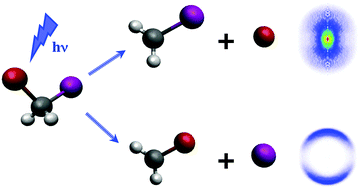Photodissociation dynamics of bromoiodomethane from the first and second absorption bands. A combined velocity map and slice imaging study†
Abstract
The photodissociation dynamics of bromoiodomethane (CH2BrI) have been investigated at the maximum of the first A and second A′ absorption bands, at 266 and 210 nm excitation wavelengths, respectively, using velocity map and slice imaging techniques in combination with a probe detection of both iodine and bromine fragments, I(2P3/2), I*(2P1/2), Br(2P3/2) and Br*(2P1/2) via (2 + 1) resonance enhanced multiphoton ionization. Experimental results, i.e. translational energy and angular distributions, are reported and discussed in conjunction with high level ab initio calculations of potential energy curves and absorption spectra. The results indicate that in the A-band, direct dissociation through the 5A′ excited state leads to the I(2P3/2) channel while I*(2P1/2) atoms are produced via the 5A′ → 4A′/4A′′ nonadiabatic crossing. The presence of Br and Br* fragments upon excitation to the A-band is attributed to indirect dissociation via a curve crossing between the 5A′ with upper excited states such as the 9A′. The A′-band is characterized by a strong photoselectivity leading exclusively to the Br(2P3/2) and Br*(2P1/2) channels, which are likely produced by dissociation through the 9A′ excited state. Avoided crossings between several excited states from both the A and A′ bands entangle however the possible reaction pathways.



 Please wait while we load your content...
Please wait while we load your content...